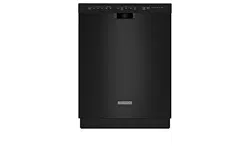Documents: Go to download!
User Manual
- User Manual - (English, French, Spanish)
- Energy Guide - (English)
- Warranty - (English)
- Installation Instructions - (English)
- Dimension guide - (English)
- Parts and Features
- Start-Up/Quick Reference (varies by model)
- Quick Steps
- Dishwasher Use
- Cycle and Option Descriptions
- Dishwasher Features
- Filtration System
- Dishwasher Care
- Troubleshooting
Table of contents
User manual Dishwasher
Parts and Features

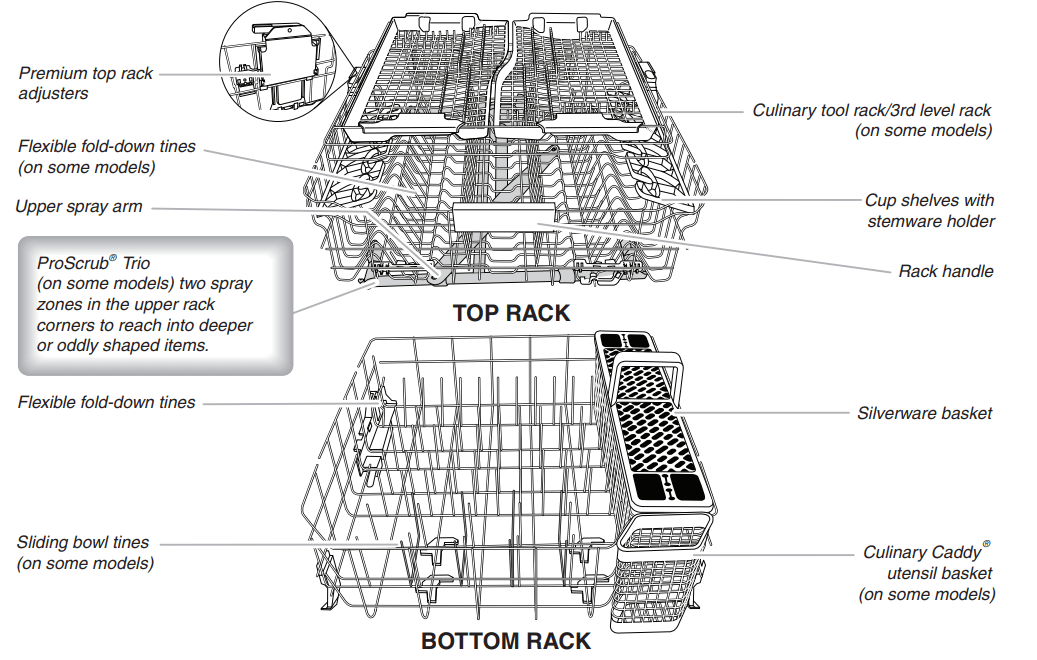
Start-Up/Quick Reference (varies by model)
Clean EQ Wash System removable filters to maintain peak performance
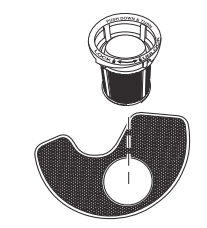
- Cleaning the filters periodically helps keep the dishwasher working at peak performance. The filters can be found at the bottom center of your dishwasher.
- See the “Filtration System” section for information on removing and maintaining the filters.
IMPORTANT: Do not block detergent dispenser.
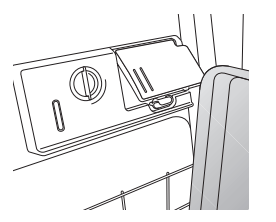
- For hinged style detergent dispensers, tall items placed in the lower rack may block the dispenser door. Cookie sheets and cutting boards loaded on the left-hand side of the dishwasher can easily block the dispenser. If detergent is inside of the dispenser or on the bottom of the tub after the cycle is complete, the dispenser was blocked.
Drying – Rinse Aid is essential.

- You must use a drying agent such as a rinse aid for good drying performance (sample included). Rinse aid along with the ProDry™ option will provide best drying and avoid excessive moisture in the dishwasher interior.

- For best drying, use the Heat Dry or ProDry™ option.
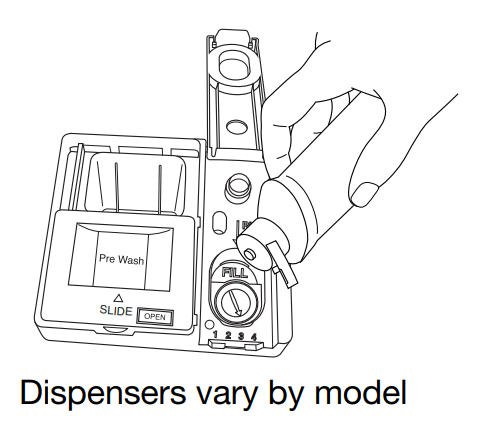
Express Wash - When you need fast results.

- Efficient dishwashers run longer to save water and energy, just as driving a car slower saves on gas. When you need fast results, the Express Wash will clean your dishes using slightly more water and energy. Select the Heat Dry or ProDry™ option to speed drying times (adds approximately 27 to 35 minutes to the Express Wash cycle).
ProWash™ cycle for optimal cleaning

- The most advanced and versatile cycle. ProWash™ cycle senses the load size, soil amount, and toughness of soil, to adjust the cycle for optimal cleaning, using only the amount of water and energy needed. The ProWash™ and Tough cycles are recommended for tough soil. No need to prerinse dishes; just scrape and load.
ProScrub® Option to clean baked-on food (on some models)
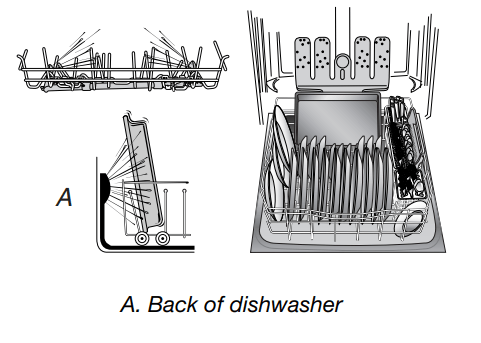
- When the ProScrub® option is selected, it provides a concentrated wash on the back of the lower dish rack for hard-to-clean dishes. Place these dishes with the soiled surface of the dish toward the ProScrub® spray jets in the lower rack of the dishwasher.
- The upper rack has 2 spray zones in the front corners to reach into deeper or oddly shaped items
Press START/RESUME every time you add a dish.

- IMPORTANT: If anyone opens the door (such as, for adding a dish, even during the Delay Hours option), the Start/Resume button must be pressed each time. If the Start/Resume button is located on top of door: Push door firmly closed within 3 seconds of pressing START/RESUME.
- If the door is not closed within 3 seconds, the Start/ Resume button LED will flash, an audible tone will be heard, and the cycle will not start.
Proper Detergent Dosing
- It is possible to use too much detergent in your dishwasher. This can lead to etching of your dishes. See “Add Detergent” and “Add Rinse Aid” in the “Dishwasher Use” section, to determine the amount of detergent needed based on your water hardness.
Quick Steps
1. Prepare and load dishwasher.
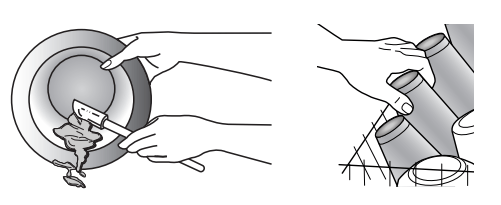
2. Add detergent for cleaning and rinse aid for drying.
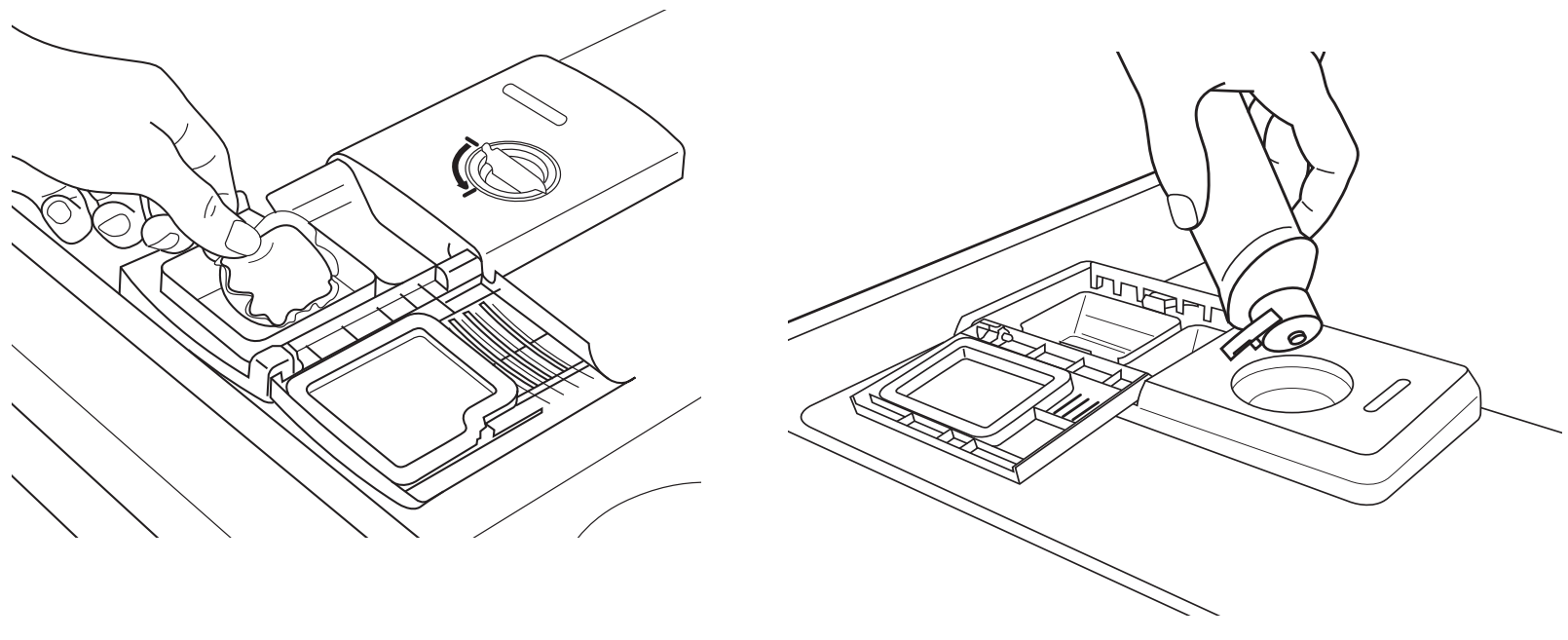
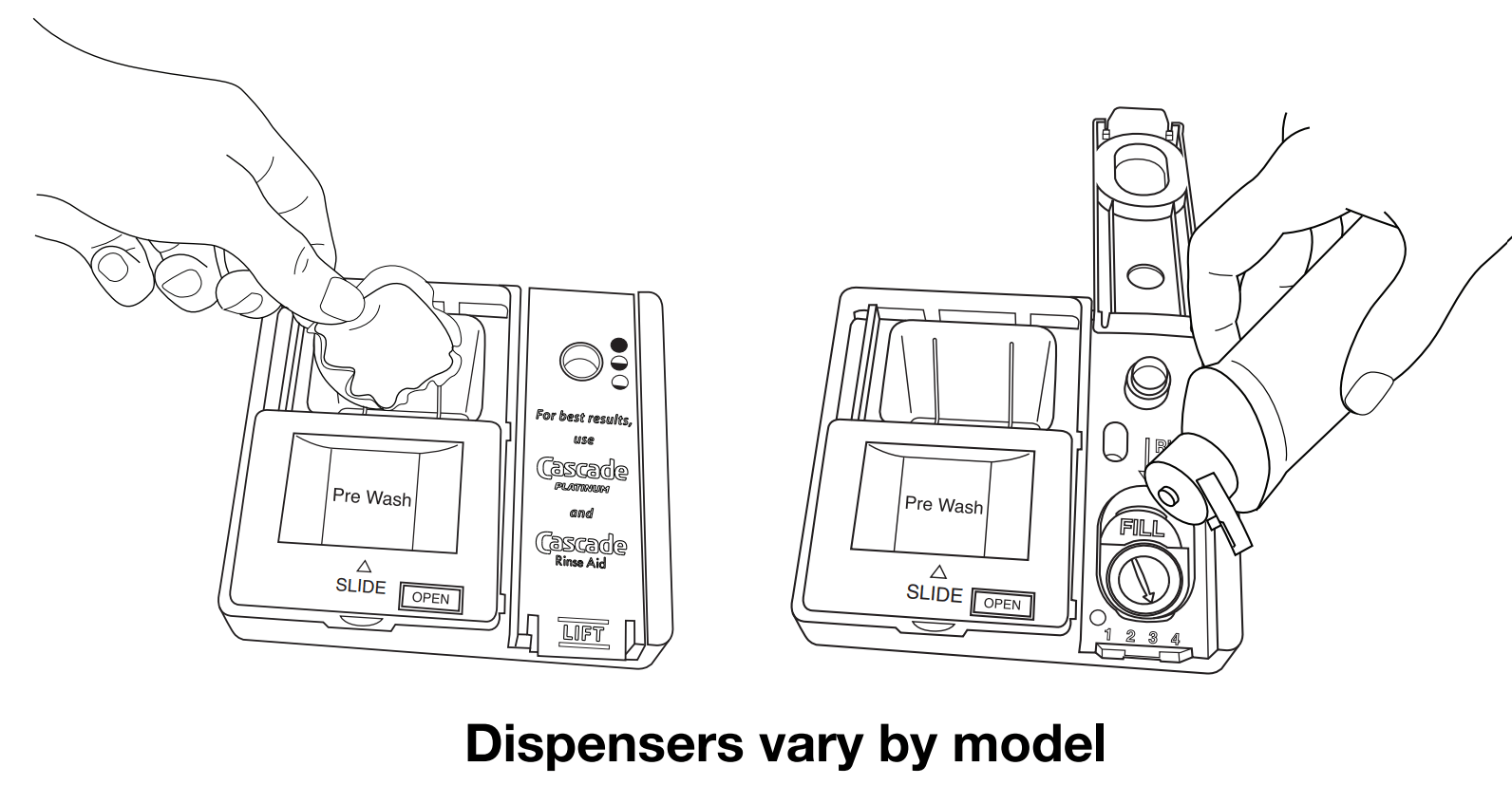
3. Select a cycle and option.
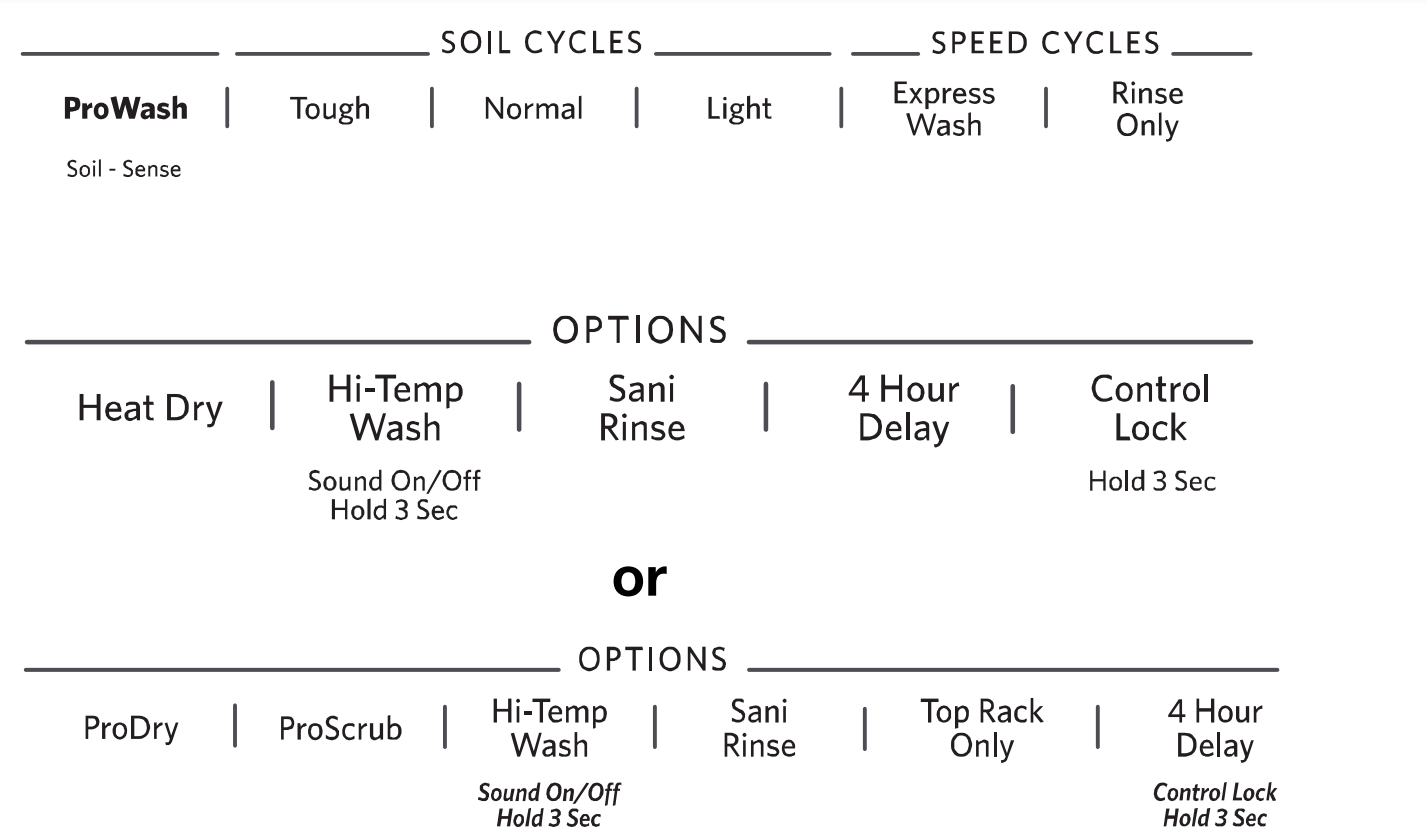
4. Start dishwasher. NOTE: If the Start/Resume button is located on the top of door, push door firmly closed within 3 seconds of pressing START/RESUME.

Dishwasher Use
STEP 1
Prepare and Load the Dishwasher
IMPORTANT: Remove leftover food, bones, toothpicks, and other hard items from the dishes. Remove labels from containers before washing.
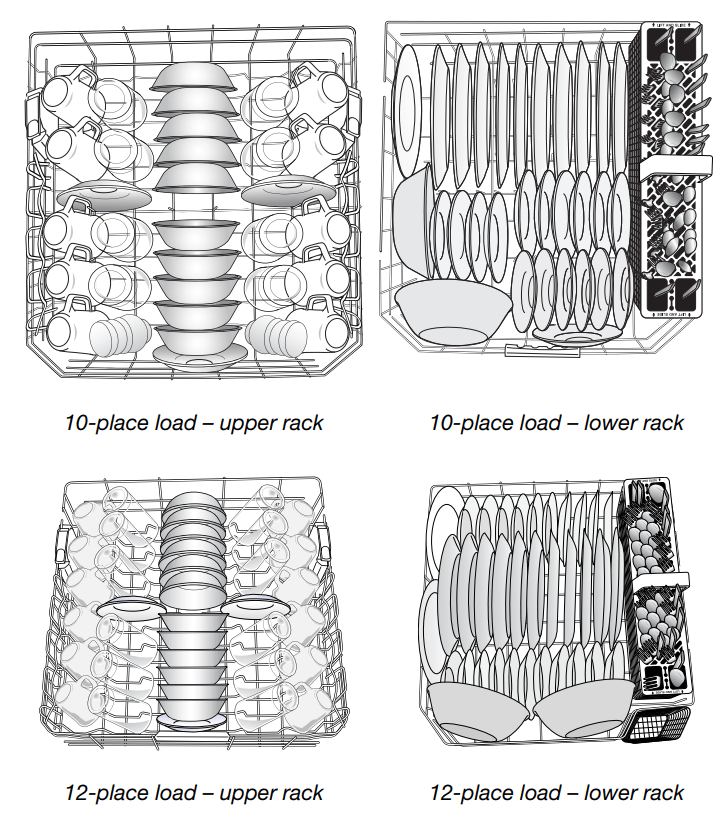
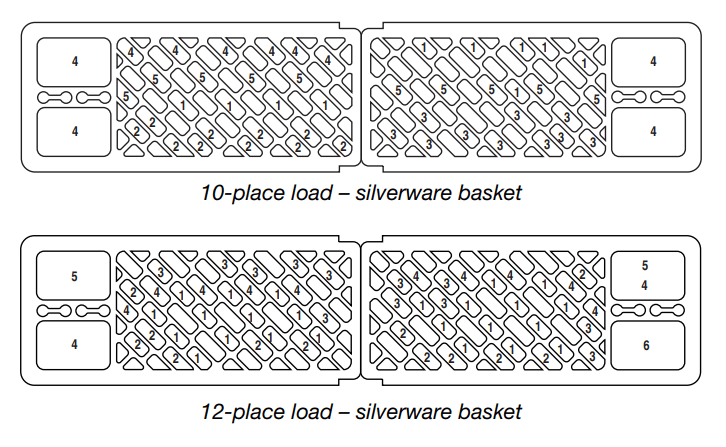
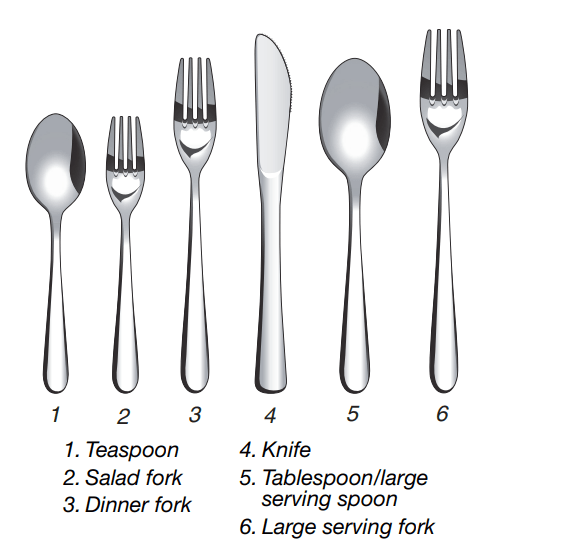
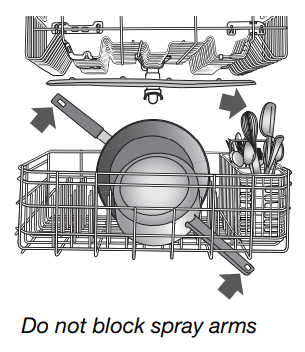
- Make sure nothing keeps spray arm(s) from spinning freely. It is important for the water spray to reach all soiled surfaces.
- Make sure that when the dishwasher door is closed, no items are blocking the detergent dispenser.
- Items should be loaded with soiled surfaces facing down and inward to the spray as shown. This will improve cleaning and drying results.
- Avoid overlapping items like bowls or plates that may trap food.
- Place plastics, small plates, and glasses in the upper rack. Wash only plastic items marked “dishwasher safe.”
- To avoid thumping/clattering noises during operation, load dishes so they do not touch one another. Make sure lightweight load items are secured in the racks.
- Improper loading can cause dishes to be chipped or damaged. When loading glasses or mugs, it is best to load these items in between rows of tines instead of loading them over tines as shown.
- When loading silverware, always place sharp items pointing down. Mix items in each section of the basket with some pointing up and some down to avoid nesting. Spray cannot reach nested items
STEP 2
Add Detergent
NOTE: If you do not plan to run a wash cycle soon, run a rinse cycle. Do not use detergent.
- Use automatic dishwasher detergent only. Add powder, liquid, or tablet detergent just before starting a cycle.
- Fresh automatic dishwasher detergent results in better cleaning. Store tightly closed detergent container in a cool, dry place
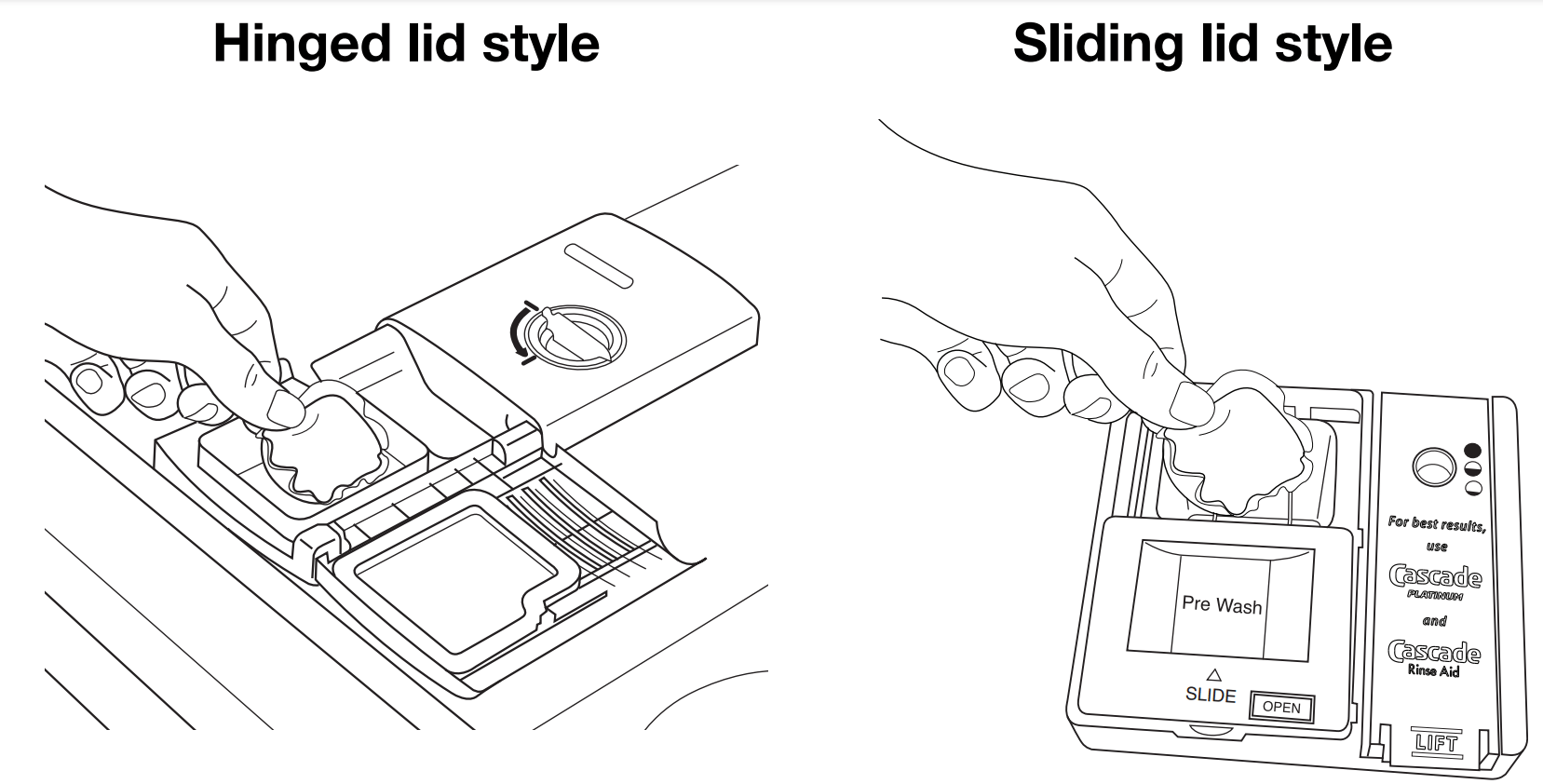
Premeasured Detergents
- Many detergents now come in several forms (gel packs, tablets, or powder packs).
- We recommend that you use high quality tablets or packs for convenience and improved performance. High quality tablets and packs have been proven better than powder, liquid, or gel detergents at reducing filming on dishes. Using tablets and packs over time will start to reduce or eliminate white film. Also, by using a rinse aid, you can minimize repeat buildup of white film. These forms are suitable for all hardness and soil levels. Always place detergents in the main compartment and slide lid to close.
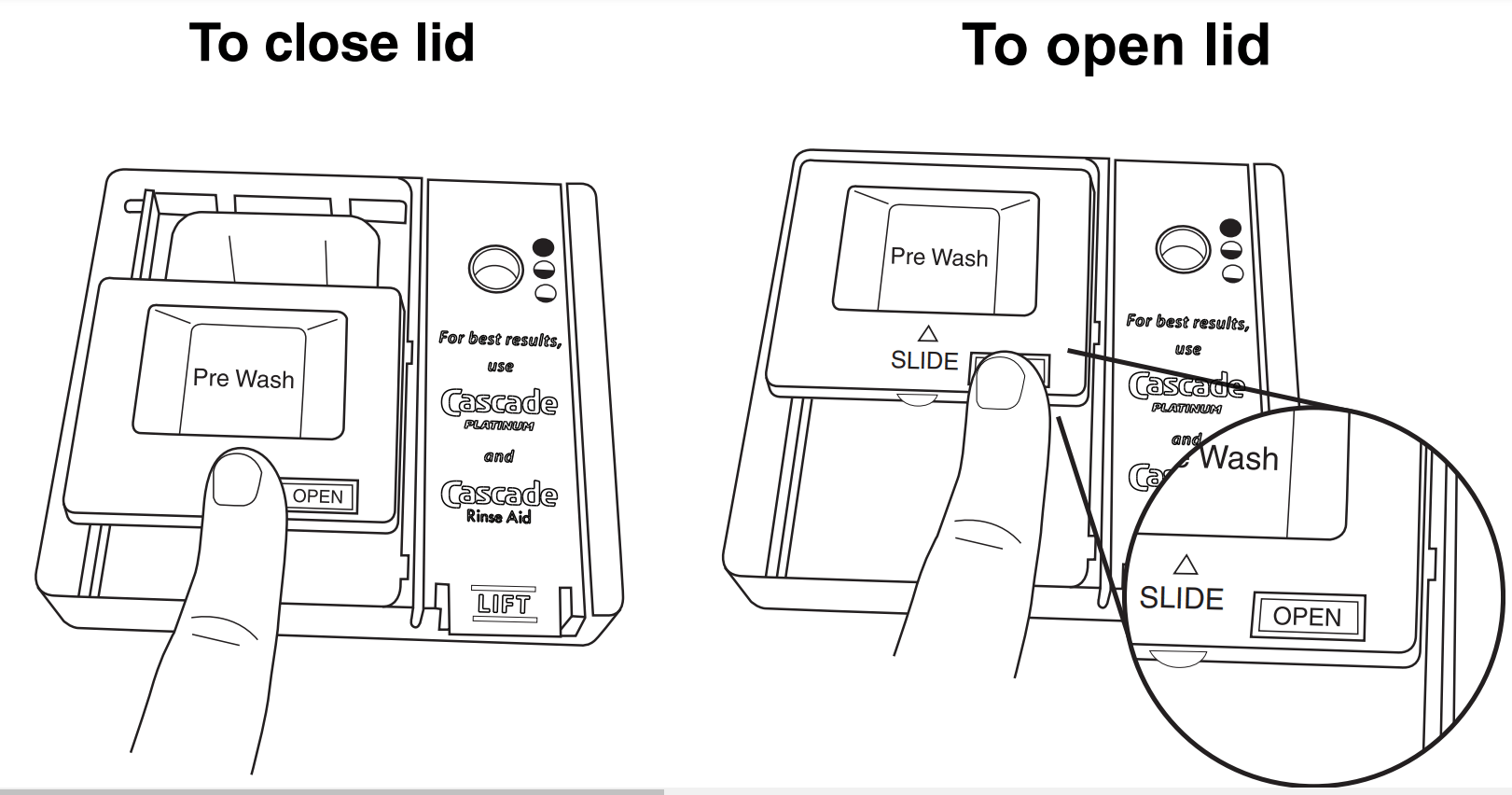
- Place selected detergent in the dispenser. Place finger, as shown, and slide lid closed. Press firmly until it clicks.
- Push OPEN, as shown, and the lid will slide open.
Powders and Gels
- The amount of detergent to use depends on: How much soil remains on the items – Heavily soiled loads require more detergent. The hardness of the water – If you use too little in hard water, dishes won't be clean. If you use too much in soft water, glassware can etch.
- Soft to Medium Water (0-6 grains per U.S. gallon) [typical water softener water and some city water] Medium to Hard Water (7-12 grains per U.S. gallon) [well water and some city water]
- Depending on your water hardness, fill the Main Wash section of the dispenser as shown. Fill the Pre-Wash section to the level shown if needed.
NOTE: Fill amounts shown are for standard powdered detergent. Follow instructions on the package when using gel dishwasher detergents. Premeasured forms are suitable for all hardness and soil levels. Always place premeasured detergents in the main compartment and close the lid.
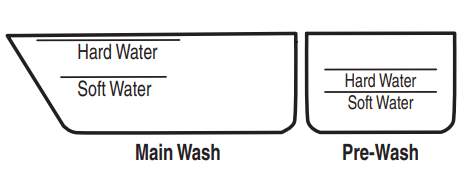
Add Rinse Aid (dispenser varies by model)
- Your dishwasher is designed to use rinse aid for good drying performance. Without rinse aid, your dishes and dishwasher interior will have excessive moisture. The Heat Dry or ProDry™ option will not perform as well without rinse aid.
- Rinse aid keeps water from forming droplets that can dry as spots or streaks. It also improves drying by allowing water to drain off of the dishes after the final rinse.
- Rinse aid helps to reduce excess moisture on the dish racks and interior of your dishwasher. STEP 2 Hinged lid style Sliding lid style To close lid To open lid Place selected detergent in the dispenser. Place finger, as shown, and slide lid closed. Press firmly until it clicks. Push OPEN, as shown, and the lid will slide open. SLIDE SLIDE SLIDE
- Check the rinse aid indicator with the door down (varies by model). Add rinse aid when indicator drops to “Add” level.
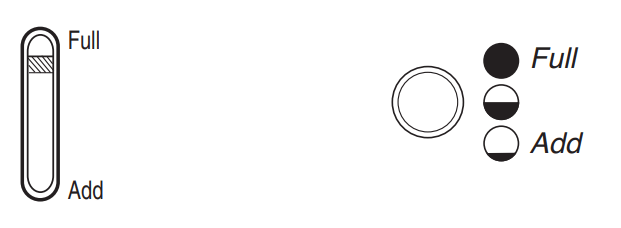
- Add rinse aid to hinged lid style dispenser by twisting the dispenser cap ¼ turn clockwise to open and lift off. Pour rinse aid into the opening until the indicator level is at “Full.” Replace the dispenser cap and turn to “Lock.” Make sure cap is fully locked.
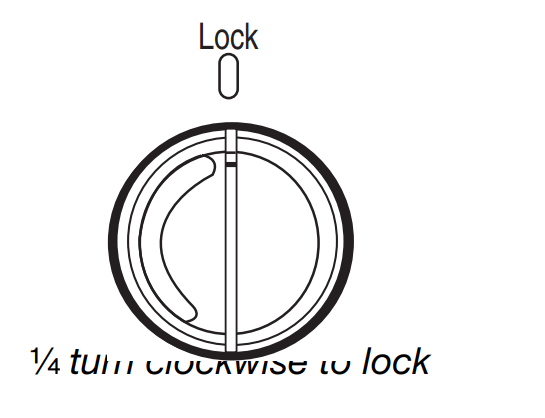
- To add rinse aid to sliding lid style dispenser, open the rinse dispenser lid by gently pushing in the center of the lid with your thumb and pulling up on the edge. Pour rinse aid into the opening until the dispenser is full. Then, close the dispenser by pushing down gently on the lid.
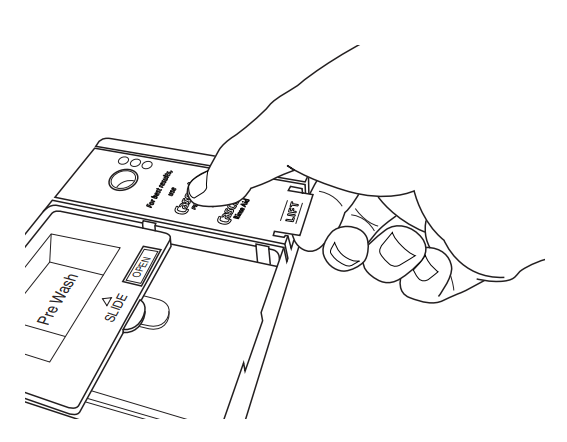
NOTE: For most water conditions, the factory setting will give good results. If you have hard water or notice rings or spots, try a higher setting. Turn the arrow adjuster inside the dispenser by either using your fingers or inserting a flat-blade screwdriver into the center of the arrow and turning.

Higher numbers dispense more rinse aid. You should change this setting only a little at a time and then run a few cycles before changing it again because just enough rinse aid is more effective than too much.
STEP 3
Select a Cycle (vary by model)
- See “Cycle and Option Descriptions” charts in the following section.
- Efficient dishwashers run longer to save water and energy, just as driving a car slower saves on gas. Typical cycle time is approximately 2¹⁄₂ hours but can take less or more time to complete depending on selections.

Select Options (vary by model)
- See “Cycle and Option Descriptions” charts in the following section.
- You can customize your cycles by pressing the options desired. If you change your mind, press the option again to turn off the option. Not all options are available for every cycle. If an invalid option is selected for a given cycle, the lights will flash.
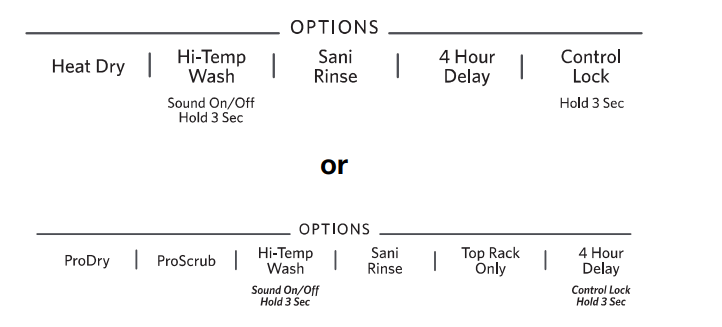
STEP 4
Start or Resume a Cycle
- Run hot water at the sink nearest your dishwasher until the water is hot. Turn off water.
- Press START/RESUME once to show which selections you used. Select the wash cycle and options desired OR press START/RESUME to repeat the same cycle and options as in the previous wash cycle.

IMPORTANT: If anyone opens the door (such as, for adding a dish, even during the Delay Hours option), the Start/Resume button must be pressed each time.
- If the Start/Resume button is located on top of door, push door firmly closed within 3 seconds of pressing START/RESUME. If the door is not closed within 3 seconds, the Start/Resume button LED will flash, an audible tone will be heard, and the cycle will not start.
Cycle and Option Descriptions

Canceling a Cycle
- Open the door slightly to stop the cycle. Wait for the spraying action to stop before completely opening the door.
- Press and hold Cancel/Drain button once. The Cancel/Drain light will light up.
- Close the door and the dishwasher starts a drain cycle (if water remains in bottom of dishwasher). Let the dishwasher drain completely. The Cancel/Drain light turns off after 2 minutes.
Changing a Cycle After Dishwasher Is Started
You can interrupt a cycle and restart your dishwasher from the beginning using the following procedure:
- Open the door slightly to stop the cycle. Wait for the spraying action to stop, then open the door completely.
- Check that detergent dispenser cover is still closed. If cover is open, you will need to refill the detergent dispenser before restarting your new cycle.
- Press and hold CANCEL/DRAIN twice to reset the control.
- Select new cycles and options.
- Press START/RESUME.
Adding a Dish After Dishwasher Is Started
- Check if Add a Dish indicator is lit. (Available on some models. Otherwise, proceed to Step 2.)
- Open the door slightly to stop the cycle. Wait for the spraying action to stop, and then open the door completely.
- Check whether the detergent dispenser cover is still closed. If it is open, a wash cycle has already started and adding a dish is not recommended.
- If detergent has not yet been used (detergent dispenser cover is closed), you may add a dish.
- Press START/RESUME.
Dishwasher Features
Your KitchenAid dishwasher may have some or all of these features.
ProScrub Option Wash Area
The ProScrub option wash area is located at the back of the lower level rack and the front corners of the upper level rack.
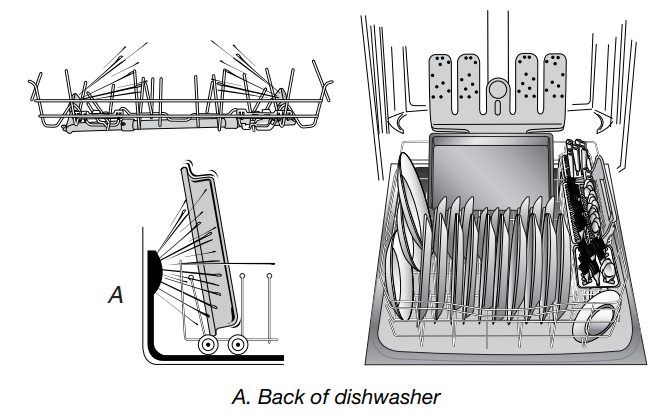
NOTE: You must select the ProScrub option to use this feature. Make sure items do not interfere with the water feed tube, spray arms, or the lower rack ProScrub spray jets.
- Keep the last tine row in the back of the lower rack in the 60° angled position when using the ProScrub® option.
- In the back of the lower rack, load pans, casserole dishes, etc., with the soiled surfaces facing the ProScrub® Plus spray jets, and resting on the last row of tines in the angled position.
- Only one row of items may face the ProScrub® spray jets. Stacking, overlapping, or nesting items will keep the ProScrub® spray jets from contacting all of the surfaces.
- In the upper rack, place tall or oddly shaped glasses or bottles in the front corners of the rack face down. It is best to load these items in between rows of tines.
ProScrub® Trio (on some models)
- Lower jets clean pans, casseroles, etc., with tough food soil to eliminate the need for soaking and scrubbing dirty, baked-on dishes.
- Upper rack has 2 spray zones in the front corners to reach into deeper or oddly shaped items.
Silverware Basket
- Use the slots in the covers to keep your silverware separated for optimum wash. There are specially designed slots (small round holes) for chopsticks. Mix silverware types to keep them separated. For best cleaning results, load knives down, forks up, and alternate spoons.
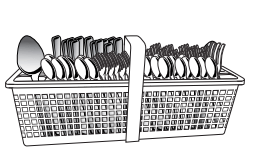
- NOTE: If your silverware does not fit into the designated slots, lift and slide the covers off of the silverware basket.

CULINARY CADDY® Utensil Basket
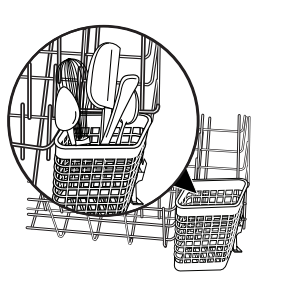
- Use the utensil basket to hold specialty cooking utensils (serving spoons, spatulas, and similar items), or overflow silverware items.
- The basket hangs on the bottom rack in the right-hand corner. Load the basket while it is on the bottom rack or remove the basket for loading on a counter or table.
- NOTE: Spin the spray arms. Be sure items in the basket do not stop the rotation of the spray arms.
SURE-HOLD® Cup and Stemware Holder
- Fold down the extra shelf on the left-hand or right-hand side of the mid level rack to hold additional cups, stemware, or long items such as utensils and spatulas.

- NOTE: Remove the culinary tool basket(s) when washing tall stemware or other tall items in the top rack.
FLEXI-FOLD DOWN™ Flexible Tines
- The row of tines on the left-hand and right-hand sides of the top rack can be adjusted to make room for a variety of dishes.

- To adjust the fold-down tines:
- Grasp the tip of the tine that is in the tine holder.
- Gently push the tine out of the holder.
- Lay the tines down, toward the center of the rack.
- NOTE: The bottom rack may also have 1 or 2 rows of flexible tines located in the back of the rack. Follow the same instructions to adjust.
Premium Adjustable 2-Position Top Rack
- After removing the culinary tool rack, you can raise or lower the top rack to fit tall items in either the top or bottom rack. Adjusters are located on each side of the top rack. Each adjuster has 2 preset positions.
- To raise the rack, press both rack adjusters and lift the rack until it is in the Up position and level.
- To lower the rack, press both rack adjusters and slide the rack to its Down position and level.
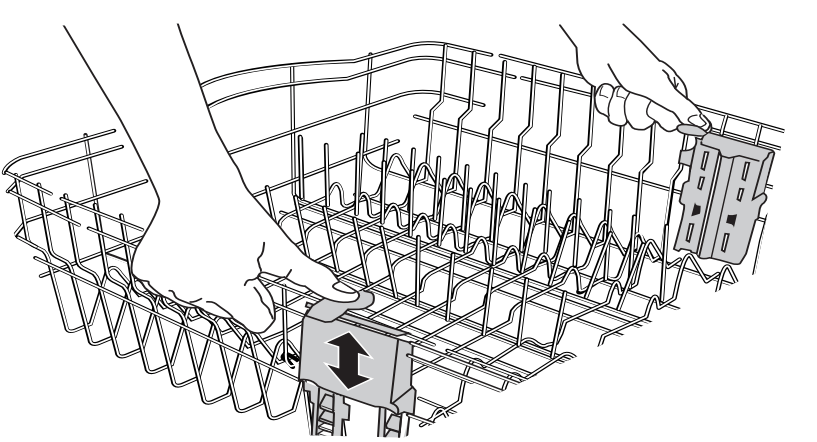
Removable Top Rack (for SatinGlide® rails)
- The removable top rack allows you to wash larger items such as pots, roasters, and cookie sheets in the bottom rack.
- IMPORTANT: Remove dishes prior to removing the top rack from dishwasher.
- To remove the rack:
- To gain access to the track stops, pull the upper rack forward about halfway out of the tub.
- To open, flip the track stop toward the outside of the tub. After opening both track stops, pull top rack out of the rails.
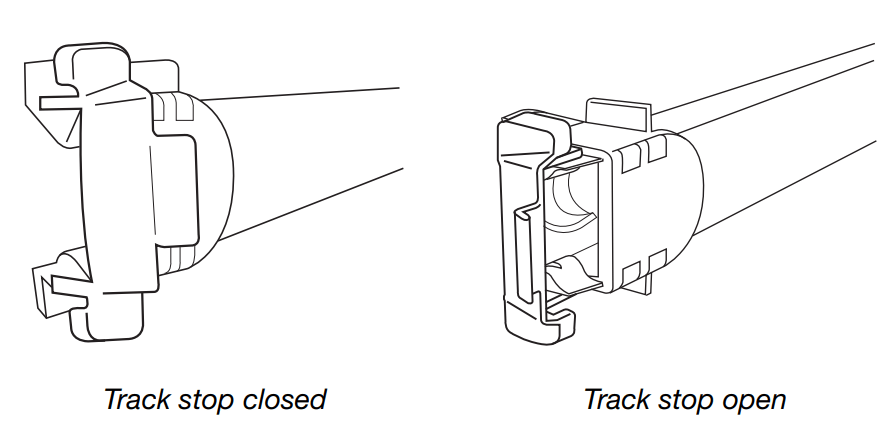
Sliding Bowl Tines
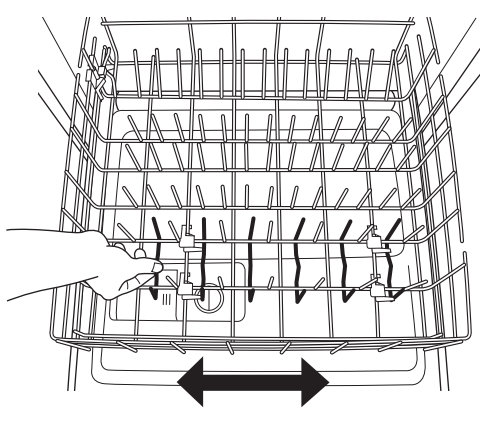
- Sliding lower-rack tines that move left or right to fit your dishes. You can use this feature to fit larger items like cereal bowls and others
Removable Top Rack (for SatinGlide® Max rails)
- The removable top rack allows you to wash larger items such as pots, roasters, and cookie sheets in the bottom rack.

- IMPORTANT: Remove dishes prior to removing the top rack from the dishwasher.
- To remove the rack:
- To gain access to the removable tabs on the tracks/rails, pull the upper rack forward about halfway out of the tub.
- On one side, press the tab on the track in and pull up the front end of the rack out of the track.
- Then repeat this step on the other side to completely remove the front end of the rack. Then remove the back end of the rack, by pulling the back end out with a slightly forward, and then upward motion.
- To replace the rack:
- Pull the tracks forward about halfway out of the tub.
- Along the sides of the racks are round attachment tabs. Align the rack's back-end attachment tabs with the cutout in the track. Push down into place.
- Pull the tracks completely out, and align the rack's front-end attachment tabs with the cutout in the track. Push down into place. You will hear a snap when the front end of the rack is secured into place on each side.
Removable Culinary Tool Rack (3rd level rack)
- The removable culinary tool rack (3rd level rack) allows you to wash larger items in the upper rack, or remove both the culinary tool rack and top rack to wash larger times in the lower rack. See the “Removable Top Rack” section

- . To remove the rack:
- To access track stops, pull the rack forward until it stops and clicks into place.
- To open track stops, flip the track stop to the outside of the track.
- After opening both track stops, slide front wheels up and out of the slot in track. Continue to pull rack forward in the track and slide the back wheels up and out of the track.
- Close track stops.
- Slide rack tracks back into dishwasher.
- To replace the rack:
- Gently pull rack tracks forward in dishwasher until they stop and click into place.
- To open track stops, flip the track stop to the outside of the track.
- Place the back rack rollers on each side of the rack into the track slot and roll the rack back into the tracks.
- Insert front rack rollers on each side of the rack into the rack slots.
- Close track stops on both sides of rack and slide rack back into dishwasher.
Culinary Tool Rack (3rd level rack)
- The culinary tool rack is designed with 2 movable baskets to hold extra silverware, knives, and cooking utensils.
- Install the baskets in this Up position when you have extra silverware and flatware to wash.

- Install the baskets in this down position when you have extra silverware, knives, or utensils requiring more room to wash.
- IMPORTANT: When you are using the culinary tool baskets in the down position, the top rack must also be in the lowest position.
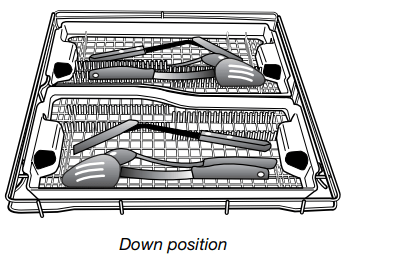
- Remove the front basket in the down position, when you are using the cup shelves or other tall items in the top rack for more room.
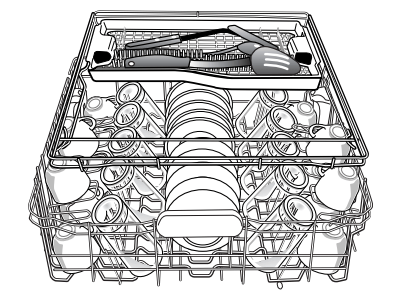
Filtration System
Your dishwasher has the latest technology in dishwasher filtration. This triple filtration system minimizes sound and optimizes water and energy conservation while providing superior cleaning performance. Throughout the life of your dishwasher, the filter will require maintenance to sustain peak cleaning performance.

The triple filter system consists of 2 parts, an upper filter assembly and a lower filter.
- The upper filter assembly keeps oversized items and foreign objects, along with very fine food particles, out of the pump.
- The lower filter keeps food from being recirculated onto your dishware.
The filters may need to be cleaned when:
- Visible objects or soils are on the upper filter assembly.
- There is degradation in cleaning performance (that is, soils still present on dishes).
- Dishes feel gritty to the touch.
It is very easy to remove and maintain the filters. The chart below shows the recommended cleaning frequency.

*Manufacturer's recommendation: This practice will conserve the water and energy that you would have used to prepare your dishes. This will also save you time and effort.
Very Hard Water
- If you have hard water (above 15 grains), clean your filter at least once per month. Building up of white residue on your dishwasher indicates hard water. For tips on removing spots and stains, see the “Troubleshooting” section.
Filter Removal Instructions
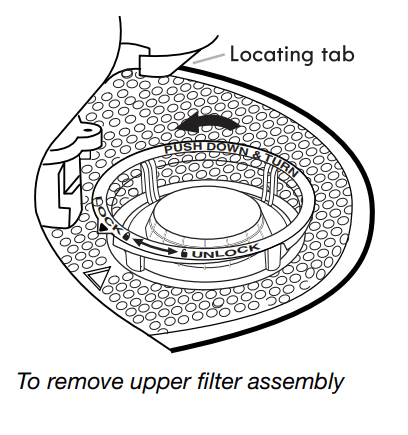
- Turn the upper filter assembly ¼ turn counterclockwise and lift out.
- Grasp the lower filter in the circular opening, lift slightly, and pull forward to remove.
- Clean the filters as shown below.
Cleaning Instructions
- IMPORTANT: Do not use wire brush, scouring pad, etc., as they may damage the filters.
- Rinse filter under running water until most soils are removed. If you have hard-to-remove soils or calcium deposits from hard water, a soft brush may be required.
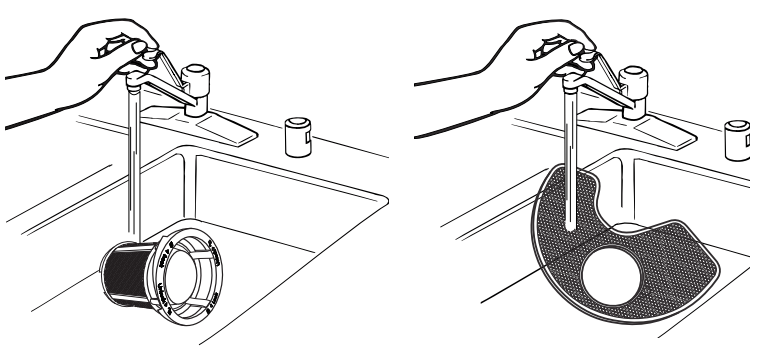
Filter Reinstallation Instructions
- Noting the previous illustrations, place the lower filter under the locating tabs in the bottom of the dishwasher so the round opening for the upper filter assembly lines up with the round opening in the bottom of the tub.

- Insert the upper filter assembly into the circular opening in the Lower Filter.
- Slowly rotate the filter clockwise until it drops into place. Continue to rotate until the filter is locked into place. If the filter is not fully seated (still turns freely), continue to turn the filter clockwise until it drops and locks into place. NOTE: The upper filter assembly arrow does not have to align with the arrow in the lower filter as long as the filter is locked.
IMPORTANT: To avoid damage to dishwasher, do not operate your dishwasher without the filters properly installed. Be sure the lower filter is securely in place and the upper filter assembly is locked into place. If the upper filter assembly turns freely, it is not locked into place
Dishwasher Care
Cleaning
Cleaning the exterior
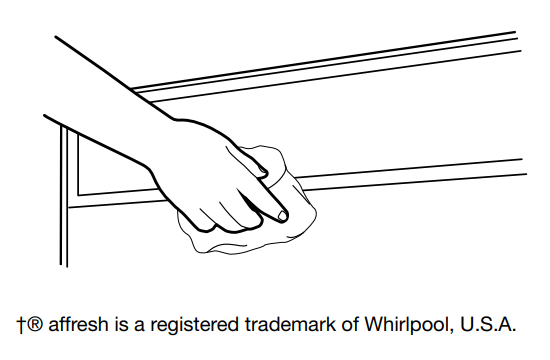
- In most cases, regular use of a soft, damp cloth or sponge and a mild detergent is all that is necessary to keep the outside of your dishwasher looking nice and clean. If your dishwasher has a stainless steel exterior, a stainless steel cleaner is recommended, such as affresh®† Stainless Steel Cleaner Part Number W10355016.
Cleaning the interior

- Hard water minerals can cause a white film to build up on the inside surfaces, especially just beneath the door area.
- Do not clean the dishwasher interior until it has cooled. You may want to wear rubber gloves. Do not use any type of cleanser other than dishwasher detergent because it may cause foaming or sudsing.
- To clean interior: Make a paste with powdered dishwasher detergent on a damp sponge and clean.
- OR Use liquid automatic dishwasher detergent and clean with a damp sponge.
- OR See the vinegar rinse procedure in “Cloudy or spotted dishware (and hard water solution)” in the “Troubleshooting” section.
- NOTE: Run a normal cycle with dishwasher detergent after cleaning the interior.
Dishwasher Maintenance Procedure
- Cleaning the Dishwasher: Clean the exterior of dishwasher with a soft, damp cloth and mild detergent. If your dishwasher has a stainless steel exterior, a stainless steel cleaner is recommended, such as affresh® Stainless Steel Cleaner Part Number W10355016.
- Removal of Hard Water / Filming:
- Recommended use of a monthly maintenance product such as affresh® Dishwasher Cleaner Part Number W10282479.
- Load your dishwasher (preferably with dishes affected by filming/hard water).
- Place tablet in main wash compartment of detergent dispenser.
- Select cycle/option best for heavily soiled dishes and start dishwasher.
- NOTE: Recommended to use a premeasured detergent tablet or pack for regular daily use.
- Recommended use of a monthly maintenance product such as affresh® Dishwasher Cleaner Part Number W10282479.
Drain Air Gap
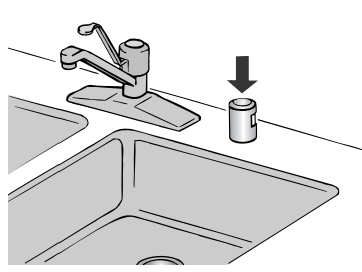
- Some state or local plumbing codes require the addition of a drain air gap between a built-in dishwasher and the home drain system. Check the drain air gap when your dishwasher is not draining well.
- The drain air gap is usually located on top of the sink or countertop near the dishwasher.
- NOTE: The drain air gap is an external plumbing device that is not part of your dishwasher. The warranty provided with your dishwasher does not cover service costs directly associated with the cleaning or repair of the external drain air gap.
To clean the drain air gap: Clean the drain air gap periodically to ensure proper drainage of your dishwasher. With most types, you lift off the chrome cover. Unscrew the plastic cap. Then check for any soil buildup. Clean if necessary
Vacation or Extended Time Without Use
To reduce the risk of property damage
- If you will not be using the dishwasher during the summer months, turn off the water and power supply to the dishwasher.
- Make sure the water supply lines are protected against freezing conditions. Ice formations in the supply lines can increase water pressure and damage your dishwasher or home. Damage from freezing is not covered by the warranty.
- When storing your dishwasher in the winter, avoid water damage by having your dishwasher winterized by authorized service personnel.
Troubleshooting
| PROBLEM | SOLUTION |
| DISHWASHER DOES NOT RUN |
NOTE: It is normal for the dishwasher to repeatedly pause several times during a cycle. If the Start/Resume light is blinking, close the door and push START/RESUME. Be sure the door is closed and latched. Be sure you have disabled Sleep mode by pressing either START/RESUME or CANCEL, or opening and closing the door before selecting your cycle/option. Check that there is not an interference with large casserole dishes and the wash system at the back of the dishwasher. Adjust loading as necessary to ensure door is closed and latched. Be sure you have selected a cycle. See the “Cycle and Option Descriptions” section. Be sure there is power to the dishwasher. A circuit breaker or fuse may have tripped. If lights other than Start/Resume blink and the unit will not run, you will need to call for service. |
| DETERGENT REMAINS IN THE DISPENSER OR TABLET IS ON BOTTOM OF TUB |
Check for dishware, such as cookie sheets, cutting boards, or large containers, etc., that may be blocking the detergent dispenser from opening properly. Be sure your detergent is fresh and lump free. Be sure the cycle has completed (the Clean light is on). If it has not completed, you will need to resume the cycle by closing the door and pressing START/RESUME. |
| CYCLE RUNS TOO LONG |
NOTES:
Try the Express Wash cycle. Run the hot water at a faucet close to the dishwasher before starting the cycle. |
| DISHWASHER NOT DRYING |
NOTE: Plastic and items with nonstick surfaces are difficult to dry because they have a porous surface which tends to collect water droplets. Towel drying may be necessary. Use of rinse aid along with the ProDry™ or Heat Dry option is needed for proper drying. Proper loading of items can affect drying. (See specific loading instructions within this guide.) Glasses and cups with concave bottoms hold water. This water may spill onto other items when unloading.
|
| WILL NOT FILL |
Be sure the water is turned on to the dishwasher. Check that the float is free from obstructions. See the “Parts and Features” section. Check for suds in the dishwasher. If foam or suds are detected, the dishwasher may not operate properly or may not fill with water. See “Blinking Lights” in the “Troubleshooting” section. |
| WATER REMAINS IN THE TUB/WILL NOT DRAIN |
Be sure the cycle has completed (the Clean light is on). If it has not, you will need to resume the cycle by closing the door and pressing START/RESUME. If dishwasher is connected to a food waste disposer, be sure the knockout plug has been removed from the disposer inlet. Check for kinks in the drain hose. Check for food obstructions in the drain or disposer. Check your house fuse or circuit breaker |
| HARD WATER (WHITE RESIDUE ON DISHWASHER INTERIOR OR GLASSWARE) |
NOTE: Extremely hard water mineral deposits can cause damage to your dishwasher and make it difficult to achieve good cleaning. A water softener is strongly recommended if your hardness is 15 grains or more. If a water softener is not installed, the following may help: Use a commercial cleaner designed for dishwashers once per month. Clean the upper and lower filters at least once per month. (See “Cleaning Instructions” in the “Filtration System” section.) Always use a rinse aid. Always use a high-quality, fresh detergent. Use a detergent booster/water softener additive designed for dishwashers. |
| ODORS |
NOTE: If the dishwasher is not used daily, you can run a rinse cycle with the partial load until a full load is ready to run, or use the Top Rack Only option (on some models) for partial loads. Run a vinegar rinse through the dishwasher by putting 2 cups (500 mL) of white vinegar in an upright glass measuring cup in the lower rack. Run a normal cycle with the Heat Dry or ProDry™ option turned off. Do not use detergent. The dishwasher may not be draining properly, see “Water Remains In The Tub/Will Not Drain” in the “Troubleshooting” section. |
| NOISY |
NOTES:
Be sure the filters are properly installed. A thumping sound may be heard if items extend beyond the racks and interfere with the wash arms. Readjust the dishware and resume the cycle. |
| FOOD SOILS REMAIN ON DISHES |
Be sure the dishwasher is loaded correctly. Improper loading can greatly decrease the washing performance. See the “Dishwasher Use” section. Check filter to ensure it is properly installed. Clean it if needed. See the “Cleaning Instructions” in the “Filtration System” section for details. Select the proper cycle and option for the type of soils. The ProWash™ or the Tough cycle with the ProScrub® (on some models) option can be used for tougher loads. Be sure the incoming water temperature is at least 120°F (49°C). Use the proper amount of fresh detergent. More detergent is needed for heavier soiled loads and hard water conditions. Scrape food from dishes prior to loading (do not prerinse). |
| DISHES DIRTY/SUDS IN DISHWASHER/CYCLE NOT COMPLETE |
If foam or suds are detected by the dishwasher sensing system, the dishwasher may not operate properly or may not fill with water. Suds can come from:
Call for service. If no water was present in the machine at any time during a heated wash cycle, the cycle will end and the Clean LED will not come on. See “Will Not Fill” in the “Troubleshooting” section. |
| SANITIZED LIGHT BLINKING | If the sanitized light is blinking, the load is NOT sanitized. The cycle was interrupted in the final rinse, or the temperature for your water heater is set too low. Set your water heater to 120ºF (49°C). |
| DAMAGE TO DISHWARE | Improper loading can cause dishes to become chipped or damaged. (See specific loading instructions within this guide.) |
| BLINKING LIGHTS |
Blinking LEDs will occur when the cycle is paused or when the cycle has been interrupted by opening the door. In this case, the Start/Resume button LED, the Cycle Status indicator LED(s), and the countdown bars on the Cycle Status display all blink together to indicate that attention is needed. See “Start or Resume a Cycle” in the “Dishwasher Use” section. Blinking LEDs can also occur when certain errors have been detected. In this case, the Clean/Complete LED will blink 4 times in a row with a pause in between each set of blinks. When this error occurs, the controls will lock out and not allow another cycle to be started. Call for service. |
| CLOUDY OR SPOTTED DISHWARE (AND HARD WATER SOLUTION) |
NOTES:
Confirm that the cloudiness is removable by soaking the item in white vinegar for 5 minutes. If the cloudiness disappears, it is due to hard water. Adjust the amount of detergent and rinse aid. See “Hard Water (White Residue on Dishwasher Interior or Glassware)” in the “Troubleshooting” section. If it does not come clear, it is due to etching (see below). Be sure the incoming water temperature is set at 120°F (49°C). Try using the High Temp and Sani Rinse options. To remove spotting, run a vinegar rinse through the dishwasher.
|
| ETCHING (PERMANENT CLOUDINESS) | This is an erosion of the surface of the glassware and can be caused by a combination of: water that is too hot, from using too much detergent with soft water, or by pre-washing. Detergent needs food soil to act upon. If etching has occurred, the glassware is permanently damaged. To avoid further etching, adjust the detergent amount to match the water hardness, stop pre-washing, and use water heating options only when incoming water temperature is below 120°F (49°C). |
| LEAKING WATER |
Be sure dishwasher has been installed properly and is level. Suds can cause the dishwasher to overflow. Measure the detergent accurately and use only detergents designed for use in a dishwasher. Less detergent is needed in soft water. Try another brand of detergent if sudsing continues. To avoid rinse aid leaking from the dispenser, be sure the lid is securely attached and avoid overfilling. |
| TUB IS DISCOLORED |
NOTES:
|
See other models: JXW8536HS RGD4440YQ GU2400XTPQ YGH5184XPQ GX5SHDXTQ
